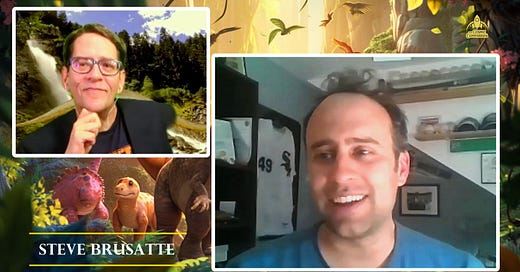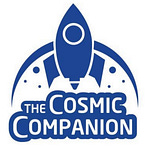Hello everyone!
Welcome back to The Cosmic Companion. I’m James Maynard. This week, it’s Apocalypse 2.0: From Dinosaurs to Doomsday. Dooooommmmsssdayyyy!!!! We’ll be talking with Steve Brusatte (consulting paleontologist for Jurassic World Dominion), on How to Survive in the Age of Dinosaurs, from Nat Geo!
Now, life 66 million years ago was far different than the one we inhabit today. In fact… You know what? I’m pretty sure I have a time machine around here somewhere. Give me a minute…
Ah. Here we go. We set this for the end of the Cretaceous Period, 66 million years ago last Thursday, and... [pause]
Listen to the podcast version of this episode here or watch it as a video!
Here we are.
For most of the 150 million years or so that dinosaurs ruled the planet, the landmasses of Earth were concentrated into the supercontinent Pangaea.
Now, near the end of the Cretaceous Period, this massive landmass is starting to tear apart, forming the Atlantic Ocean.
Over two million years, western regions of North America were home to 1.7 billion Tyrannosaurus Rex, along with Triceratops, Edmontosaurus, Ankylosaurus, and the Pachycephalosaurus.
Far larger than any of these beasties were Titanosaurs who lived in what is now India. Some of these may have measured 15 to 20 metres long, or 75 to 100 adult cardinals in length.
Living in the lands we now call Montana and the Dakotas, was a ferocious, if tiny, little beast known as the Anzu. With a distinctive thick crest on their head, a beak, and no teeth, their friends call them “chickens from Hell.” Just… not to their faces.
What? You don’t think chickens can stand up for themselves? Watch this!
—
Roughly 66 million years ago, an asteroid larger than Mount Everest bore down on the Earth, impacting The Yucatan Peninsula, sending flames and tsunamis spreading around the globe. Dust and debris thrown into the atmosphere blocked out the Sun for up to two years, stunting plant growth around the world. Sulfuric acid aerosols quickly acidified the oceans. Soon, 70 percent of all plants and animal species around the world were no more.
Bird-like dinosaurs and small mammals, however, would soon take back this battered world.
Next up, we are going to talk with Steve Brusatte (consulting paleontologist for Jurassic World Dominion), talking about this ancient era, and on How to Survive in the Time of Dinosaurs, from Nat Geo!
—
NEXT THURSDAY:
NEWSROOM
Good Evening. I’m Rachel Ratingsgrabber, and I’m here with my partner, Todd Panicstorm.
Protesters spent their third day at City Hall today calling for cuts in spending for space and science. Organizers say they “have no idea how science could be used in real life.”
NEWSROOM
TODD: And, we have a breaking story… Astronomers report a large asteroid has just appeared from behind the Sun. Preliminary estimates are that this asteroid has a diameter of 15 kilometers. Rachel — what’s that for the five percent of the world still refusing to use Metric?
RACHEL: Well, I’ll tell you, Todd. That’s equivalent to 12,842 Herve Villechaize’s laying along one edge of a plane! a plane!
TODD: According to this finding, the asteroid will be striking Earth in… 4… 3… 2… 1… BuySuperMegaCorp!
FLASH
This asteroid strikes Los Angeles with the force of 150,000,000 million tons of TNT.
[<< Well, I’ll be. That’s the energy of 7,500,000,000 Hiroshima bombs exploding at once.]
Thanks, Joules!
In an instant, what was once a bustling metropolis was replaced by a transient crater in the ground 80 kilometers across, and 28 kilometers in depth. The force of this impact caused the ground around the initial crater to collapse, filling the basin with debris. The final crater measures 140 kilometers across, and 1,300 meters deep, with walls nearly as high as the Grand Canyon.
The resulting air blast was the first effect of the impact felt outside Los Angeles. Steel buildings were knocked down as far away as San Jose and San Francisco. Wooden structures collapsed over most of the United States, Canada, and Mexico, as far east as Orlando and Pittsburgh. Straw buildings… Well, those weren’t a great idea to begin with, honestly.
The massive firestorm from the impact engulfed an area from Santa Barbara down to San Diego and the funnest place in the world, Tijuana.
Clothing caught fire as far north as Portland, Oregon, and eastward through all of Arizona, and a good part of New Mexico, while the fireball was visible to people in Seattle and out to Albuquerque.
Debris thrown up by the ginormous impact fell back down to Earth in massive quantities, completely burying everything in Santa Barbara, and piling higher than nearly all of the once-mighty skyscrapers of San Diego, now mounds of twisted metal and shattered glass.
Perhaps fittingly, Los Angeles gave North America one last earthquake on its way out.
Across the entire region in which Los Angeles once sat — from Santa Clarita in the north to San Clemente in the south, the ground buckled, throwing objects like cars up into the air.
Further out, from San Francisco to Santa Clara, once-firm ground cracked, lifting buildings off their foundations.
From Sacramento in the north to Phoenix in the east, poorly-made and older buildings cracked, walls tumbled, and pedestrians lost their footing.
Meanwhile, behemoth tsunamis formed by the collision raged through the Pacific Ocean, drowning low-lying coastal regions. Water rushing in from the world’s largest body of water filled the crater, forming a new bay, greatly expanding space for an expanded Venice boardwalk which will never be built.
This debris remaining in the air is likely to block out the Sun for years, leading to crop failures around the globe, starving most of the life which survived the event.
And it appears the human race is run.
Next week on the Cosmic Companion, we’ll be exploring the Water Moons of Our Solar System, talking with Olivier Witasse, Project Scientist for the Jupiter Icy Moons Explorer mission, from the European Space Agency (ESA). Make sure to join us starting on 10 June.
If you enjoyed this episode of The Cosmic Companion, what’s wrong with you? I destroyed the world twice in the last half hour! I like you!
Head on over to TheCosmicCompanion.com and sign up for our newsletter, and never miss an episode. Share, comment follow, all that while you’re there. The world’s not over yet. I think.
Clear skies!
James













Share this post